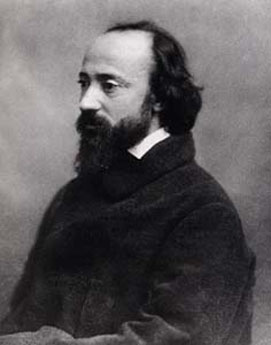| Charles-François Daubigny  Born: 15-Feb-1817 Born: 15-Feb-1817
Birthplace: Paris, France
Died: 19-Feb-1878
Location of death: Paris, France
Cause of death: unspecified
Gender: Male
Race or Ethnicity: White
Sexual orientation: Straight
Occupation: Painter Nationality: France
Executive summary: French painter of landscapes, ducks French landscape painter, allied in several ways with the Barbizon School, was born in Paris on the 15th of February 1817, but spent much time as a child at Valmondois, a village on the Oise to the northwest of Paris. Daubigny was the son of an artist, and most of his family were painters. He began to paint very early in life, and at the age of seventeen he took a studio of his own. Within twelve months he had saved enough to go to Italy, where he studied and painted for nearly two years; he then returned to Paris, not to leave it again until, in 1860, he took a house at Auvers on the Oise. By 1837 Daubigny had become famous as a river and landscape painter, although he had been devoting himself as well to drawing in black-and-white, to etching, wood engraving, and lithography. In 1855 his picture, "Lock at Optevoz", now in the Louvre, was purchased by the state; four years later Daubigny was created knight of the Legion of Honor, and in 1874 he was promoted to be an officer. In 1866, at the invitation of Frederick Leighton and others, he visited London, where, however, he was hurt by his now famous "Moonlight" being badly hung in the Old Royal Academy. But the personal encouragement of his admirers in England made up for the disappointment, and the sale of his picture to a Royal Academician greatly pleased him. In 1870-71 he again visited London, and subsequently Holland, where he painted a number of river scenes with windmills. In 1874, having returned to Paris, he fell ill, and from that time until he died (on the 19th of February 1878) his work won less distinction than before. In 1904 the municipality of Auvers-sur-Oise decided to erect a bronze monument to Daubigny's memory.
Daubigny's finest pictures were painted between 1864 and 1874, and these for the most part consist of carefully completed landscapes with trees, river and a few ducks. It has curiously been said, yet with some appearance of truth, that when Daubigny liked his pictures himself he added another duck or two, so that the number of ducks often indicates greater or less artistic quality in his pictures. One of his sayings was, "The best pictures do not sell", as he frequently found his finest achievements little understood. Yet although during the latter part of his life he was considered a highly successful painter, the money value of his pictures since his death has increased dramatically. Daubigny is chiefly preferred in his riverside pictures, of which he painted a great number, but although there are two large landscapes by Daubigny in the Louvre, neither is a river view. They are for that reason not so typical as many of his smaller Oise and Seine pictures.
The works of Daubigny are, like Camille Corot's, to be found in many modern collections. His most ambitious canvases are: "Springtime" (1857), in the Louvre; "Borde de la Cure, Morvan" (1864); "Villerville sur Mer" (1864); "Moonlight" (1865); "Andrésy sur Oise" (1868); and "Return of the Flock -- Moonlight" (1878). His followers and pupils were his son Karl (who sometimes painted so well that his works are occasionally mistaken for those of his father, though in few cases do they equal his father's mastery), Oudinot, Delpy and Damoye.
Wife: Sophie
Son: Karl Daubigny (painter)
Risk Factors: Gout, Asthma
Do you know something we don't?
Submit a correction or make a comment about this profile
Copyright ©2019 Soylent Communications
|